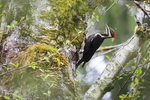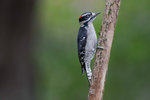

Most people know more about birds than they realize. That is true about the woodpeckers, even if all you can bring to mind are old Woody Woodpecker cartoons. The first thing, of course, is that these birds make their living by drilling into the wood for insects and that drilling makes a distinctive noise. A second observation immediately follows – woodpeckers cling to the tree trunk and branches, and this is where you are most likely to spot them.
There are several other more subtle characteristics all woodpeckers share. They nest in cavities that they excavate, usually in trees but also at times in fence posts or even utility poles. And all woodpeckers have a distinct undulating flight pattern, flying up and down rather than in a straight line. In addition to drilling, woodpeckers also use their bills to drum, likely to make a territorial claim or attract a mate. These drumming patterns vary with different species. Finally, most woodpecker species have some combination of black and white feathers, with an added dash of red on their heads, and both sexes look more or less alike.
The largest and most dramatic of our woodpeckers is the Pileated Woodpecker. It’s a big bird, bigger than a crow, and fairly common. At first, it might appear mostly black, with a distinctive red crest. But when it flies, you will see bold black and white contrast, including a white wing patch. Sometimes they can be quiet, but more often you’ll hear a loud repetitive vocalization that is written “kuk, kuk.” You can listen to its vocalization on the Merlin app or at allaboutbirds.org.
Pileated Woodpeckers have a large chisel-like bill, and they are very talented at tearing apart rotten trees, either standing or on the ground. This is their feeding pattern, of course, and they leave such a mess that you are very likely to notice it. They create a large vertical oval-shaped nest cavity. These birds live in open woodlands and, because of their size and loud vocalization and drilling, are often seen, however briefly.
There are two other, more common woodpeckers that are very similar to each other in appearance and behavior, except for their size. The smaller is the Downy Woodpecker, a relatively small bird of 6”, about the size of a large sparrow. It can appear rather dainty as it moves up and down branches probing for insects. It does drill, but it often sounds like a faint tap, tap. They have a buffy white breast and back, with black wings checkered with white dots. The male has a red stripe on the back of his head. Its call is a single note, often written “pik” but it sounds to me more like a quick “squeak.”
The Hairy Woodpecker is a larger version of the Downy, closer to 9” – more robin sized. Its color pattern is the same as its smaller cousin, but it does not ever appear to be dainty. Rather, its bill is significantly larger, and its drilling is louder and bolder. Its vocalization is similar to that of the Downy, but louder. Sometimes it might be hard to tell which of these two woodpeckers you are seeing, and hearing,
Finally, there is the Red-breasted Sapsucker. As with these other species, this bird is fairly common in our area. It has a very distinctive appearance with a red head and breast, black wings and back. It is slightly smaller than robin-sized and is vocally quiet compared to other woodpeckers. Its territorial drumming is a distinctive sound with an irregular 3 to 5 taps, a pause, and another 3 to 5 taps.
Sapsuckers gain their common name by a distinctive feeding pattern. They drill evenly spaced small holes in live trees, returning to these holes regularly to feed on sap and on insects attracted to the oozing sap. Over years, these holes form scar patterns in the tree’s bark that tell you that sapsuckers frequent the area. Look for these patterns, especially on older fruit trees.
Get up early for the dawn chorus
It’s not too late to get outside early in the morning to listen to the dawn chorus. Anytime before 7:00 a.m. or so and many of the birds will be singing. By the end of July, however, most of this morning singing will be over.
George Walter is an environmental program manager at the Nisqually Indian Tribe’s natural resources department; he also has a 40+ year interest in bird watching. He may be reached at george@theJOLTnews.com
Photos for this column are provided by Liam Hutcheson, a 14-year-old Olympia area birder and avid photographer.
Comments
No comments on this item Please log in to comment by clicking here